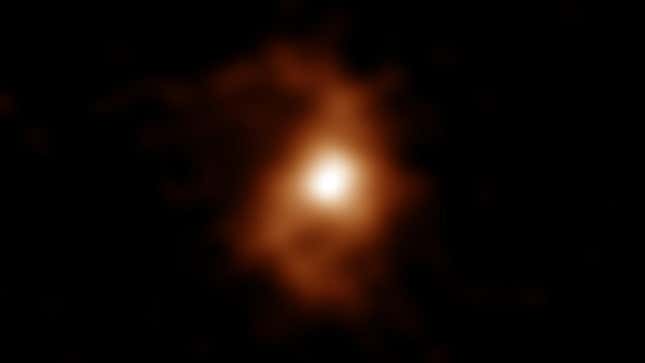
A team of Japanese astronomers recently peered way, way back in time using a telescope array in Chile. What they made out in the distant, early universe is a record-breaking galaxy, one that turns back the clock on when galaxies took on their classic spiral structures.
The team’s research was published today in Science. At first glance, it looks like the beam of a flashlight through the fog, and in some ways, it is. The light from the galaxy is 12.4 billion years old, a billion years earlier than the previous record holder for a similar structure. It was spotted by the Atacama Large Millimeter/submillimeter Array, a fantastic instrument for understanding the most ancient things (it recently dated the age of the universe itself with new specificity). The galaxy in this image must have formed within 1.4 billion years of the Big Bang, by the researchers’ assessment. The array detected carbon ion emissions from the galaxy.
According to the study authors, these protogalaxies—basically globs of gas and stars—are expected to have a rotating disk structure, similar to the galaxies you might think of today. That disk could’ve come about through very hot, chaotic energy dispersal, or “the disk may be formed by cold accretion of the gas without a chaotic phase,” said Takafumi Tsukui, an astronomer at The Graduate University for Advanced Studies in Tokyo (SOKENDAI) and the National Astronomical Observatory of Japan. “The massive disk is thought to be required for the subsequent formation of the spiral structure.”

After the Big Bang that began the universe 13.8 billion years ago, galaxies didn’t just pop up in the forms we know them today. The early universe was crammed with tiny structureless protogalaxies that flew through the crowded space, bashing into one another and merging like a cosmic mosh pit. How those amorphous protogalaxies eventually took on the spiraled arms and central bulge common in galaxies now has remained an enigma to astronomers. One theory for the arms is that they were pulled into existence through tidal interactions with other galaxies. Another is that the arms took shape when mass centrally located in the galaxy pulled other matter toward itself. Whatever the case, the fact remains that most spiral galaxies don’t appear until much later in the universe’s development. So this galaxy—BRI 1335-0417, as it’s been named—was a trailblazer.
“When and how the galaxies were formed is a perennial mystery being explored in astronomy,” said co-author Satoru Iguchi, also an astronomer at the National Astronomical Observatory of Japan and SOKENDAI.. “We discovered a spiral morphology in the galaxy BRI1335-0417 ... and, for the first time, demonstrated the most distant spiral galaxy long before the peak of the cosmic star formation,” the period when star birth rate was at its zenith around four billion years after the Big Bang.
“This study falls in line with recent discoveries of surprisingly ‘mature’ galaxies in the primeval Universe,” said Federico Lelli, an astronomer at the Arcetri Astrophysical Observatory in Italy, in an email. “Previous observations with the ALMA telescope revealed that regularly rotating gas disks and massive stellar bulges are in place only 1 billion years after the Big Bang. This work provides evidence for one more sign of ‘maturity’: spiral arms.”
Earlier this year, a team led by Lelli analyzed ALESS 073.1, a galaxy that also formed not long after the Big Bang, and found that the nascent structure had a bulge and a rotating disc of gas surrounding it, characteristics typically associated with more recently formed galaxies. Yet there they were, another ancient piece of evidence. Amanda Moffett, an astronomer at the University of North Georgia who specializes in galaxy evolution, pointed out that newer, better telescopes like ALMA will continue to push back previous record dates, as they can see farther into the universe and thus further back in time.

“A question that I think a lot of other astronomers will think about in connection with this work is whether or not this galaxy is definitely a settled spiral galaxy with perhaps a bar and loosely wound spiral structure (something like a Hubble type SBc) or actually a product of a merger with another galaxy, such that the ‘arm’ structures we see are more like tidal tails,” Moffett said in an email. “This may seem somewhat semantic, but it actually relates to the above question—whether we’re seeing an era in which spiral galaxies have already been forming and are now just calmly existing, or an era in which they’re still actively assembling and only starting to settle down into ordered galaxies.”
Indeed, the recently imaged galaxy may not quite have arms but instead a proto-arm structure that paved the way for the galaxy’s current state, whatever it may be (we’d have to wait another 12 billion years to find that out, given how long light takes to travel from there to here). Though ALMA’s gaze is basically the limit of researchers’ perception for now, the upcoming James Webb Space Telescope, which looks like a space-traveling sailboat, will let us see even more of the early universe after its planned launch on October 31, 2021.